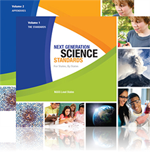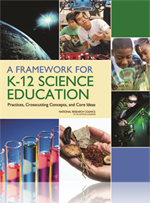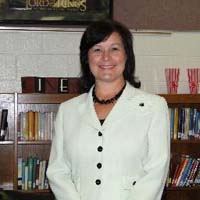The Next Generation Science Standards: Ready or Not, Here They Come!
By Guest Blogger
Posted on 2014-09-04
 This is a particularly exciting time for science educators across our nation, both for those in states that have adopted the Next Generation Science Standards (NGSS) and those in areas that will never formally take that step, as they begin the process of putting into practice the vision of science education outlined in the Framework for K–12 Science Education and the Next Generation Science Standards.
This is a particularly exciting time for science educators across our nation, both for those in states that have adopted the Next Generation Science Standards (NGSS) and those in areas that will never formally take that step, as they begin the process of putting into practice the vision of science education outlined in the Framework for K–12 Science Education and the Next Generation Science Standards.
As exciting as this time is, it would be disingenuous to suggest that this process will be an easy one. Anyone who has ever been involved in a major renovation can attest to the fact that the business of change is never fast, can be overwhelming, and is always messy. In order to succeed, science teachers must prepare themselves for this task. In order for this vision of science education to fully take hold, teachers will have to take responsibility for their own professional learning and for shifting the instruction in their classroom. Teachers will have to take the lead, but they shouldn’t expect to do it on their own. My advice to readers is to start by connecting with your colleagues, whether that is in your school or district, through NSTA’s listservs and online communities, or on broader social media like Twitter (follow @NSTA or search #NGSS for starters).
 Once you’re plugged into a professional learning community, how might you go about bringing the Framework for K-12 Science Education and the NGSS to life? First, fully familiarize yourself with the contents of both documents, beginning with the Framework, which brings together more than a decade’s worth of research on student learning in science and provides a solid foundation for the subsequent standards. This means not skipping the front matter or the appendices in order to get to the “good parts”! In fact, you might want to begin with the appendices, as they provide context and guidance for teachers as they translate the NGSS into classroom practice. Reflect deeply on your current instructional practices and compare them to those described in the Framework and NGSS.
Once you’re plugged into a professional learning community, how might you go about bringing the Framework for K-12 Science Education and the NGSS to life? First, fully familiarize yourself with the contents of both documents, beginning with the Framework, which brings together more than a decade’s worth of research on student learning in science and provides a solid foundation for the subsequent standards. This means not skipping the front matter or the appendices in order to get to the “good parts”! In fact, you might want to begin with the appendices, as they provide context and guidance for teachers as they translate the NGSS into classroom practice. Reflect deeply on your current instructional practices and compare them to those described in the Framework and NGSS.
A word of caution, it is easy to fall victim to the temptation to tell yourself that you are already using some teaching strategies that align with the Framework and NGSS. While you likely have some excellent lessons in your repertoire, this new vision of science teaching represents a true innovation for the vast majority of us. In order to shift our practice, we have to turn a critical eye toward that practice. Think about your needs in terms of professional knowledge and pedagogy and develop a plan to address those areas of need. NSTA offers a host of resources through the Learning Center and NGSS@NSTA hub, both of which can assist you in your quest for understanding.
Make sure that you fully comprehend the components of each of the three dimensions (Crosscutting Concepts, Disciplinary Core Ideas, and Science and Engineering Practices) and how each progresses in complexity with time. The term “three-dimensional learning” is often quoted when describing the NGSS, and it is this idea that sets this set of standards apart from previous ones. The term describes the intention and explicit integration of all three dimensions in teaching, learning, and assessment. Take steps to ensure that you truly understand what this term means and know what this would look like in your classroom. Second, make sure you know how to read the NGSS. The architecture of the standards is designed to provide educators with a wealth of information on each dimension of learning and coherence with the Common Core State Standards. Investigate not only the performance expectations (PEs), but look closely at the foundation boxes to see exactly which component of the science and engineering practices, disciplinary core ideas, and crosscutting concepts are addressed by the PE. Look further to see how a set of particular performance expectations connects to other disciplinary core ideas.
Next, evaluate and adapt the curricular materials you currently have access to in order to determine if they align with the three-dimensional learning called for in the NGSS. A recent NSTA blog post addresses this process (“How to Select and Design Materials that Align to the Next Generation Science Standards,” by Joe Krajcik”). This task isn’t easy and it isn’t fast, but it’s worthwhile. I have found that going through this process has increased considerably my depth of understanding regarding each component. The added benefit of this step of the journey is that you are now putting the crosscutting concepts, science and engineering practices, and disciplinary core ideas into the hands of students. Those of us in education know that it is the high we get when we see our students’ minds firing on all cylinders that keeps us going through all the faculty meetings, in-services, and state-mandated trainings.
Two resources that are invaluable in assisting with this daunting task are the Educators Evaluating the Quality of Educational Products (EQuIP) rubric, which was developed jointly by Achieve, Inc. and NSTA and Translating the NGSS for Classroom Instruction written by Rodger Bybee and available through NSTA press. The EQuIP rubric will assist you as you determine how particular materials align with the NGSS. Dr. Joe Krajcik and Dr. Brian Reiser provide guidance on how to use the EQuIP Rubric. Translating the NGSS for Classroom Instruction is a rich resource that provides systematic instructions, templates, and examples for how teachers can translate the NGSS for classroom practice.
Let me close by reiterating two themes. First, and perhaps most importantly, teachers need to complete all the aforementioned steps collaboratively. The best decisions are those which result from deep conversions with peers, except when fifteen year-old boys are involved. Personally, my greatest growth as a professional has resulted from discussions with my colleagues as we question, reflect, and evaluate together. The task is too great and too important to be fully accomplished alone. Second, remember that this will be a long-term journey full of questioning, evaluating, revising, learning, and re-learning. Despite the best efforts of multiple reform initiatives over the years, our approach to teaching and learning in science have remained stable. In order for us to truly effect change within our profession and to ensure that the current efforts become sustainable, science teachers must take the lead in their own classrooms and engage their colleagues in a steady and deliberate process of reflection and change.
 Today’s guest blogger is Zoe Evans, a middle school assistant principal in Carrollton, GA. Before becoming an administrator in 2012, Zoe served as a middle school science teacher for nineteen years. She is a National Board Certified Teacher in Early Adolescent Science, a Georgia Master Teacher, and is the 2005 Georgia recipient of the Presidential Award of Excellence in Mathematics and Science Teaching. Zoe served on the NGSS writing team. Reach her at zoe.evans@carrollcountyschools.com or via Twitter @zoe_evans.
Today’s guest blogger is Zoe Evans, a middle school assistant principal in Carrollton, GA. Before becoming an administrator in 2012, Zoe served as a middle school science teacher for nineteen years. She is a National Board Certified Teacher in Early Adolescent Science, a Georgia Master Teacher, and is the 2005 Georgia recipient of the Presidential Award of Excellence in Mathematics and Science Teaching. Zoe served on the NGSS writing team. Reach her at zoe.evans@carrollcountyschools.com or via Twitter @zoe_evans.
Follow NSTA
| |
|
|
|
Disclaimer: The views expressed in this blog post are those of the author(s) and do not necessarily reflect the official position of the National Science Teaching Association (NSTA).

